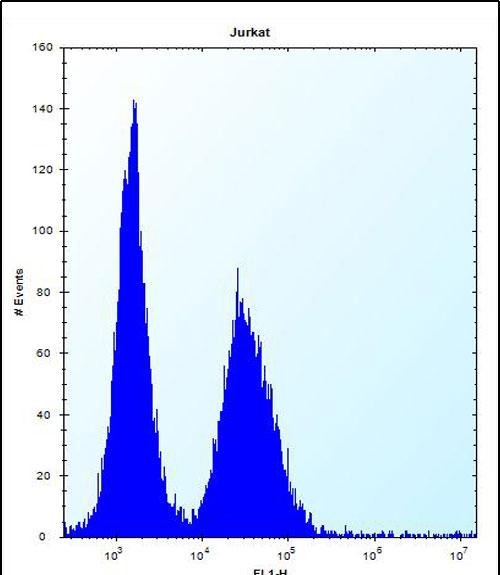DDIT3 Antibody (Center)
Affinity Purified Rabbit Polyclonal Antibody (Pab)
- 产品详情
- 文献引用 : 1
- 实验流程
- 背景知识
Application
| WB, FC, E |
|---|---|
| Primary Accession | P35638 |
| Other Accession | NP_004074.2, NP_001181986.1 |
| Reactivity | Human |
| Host | Rabbit |
| Clonality | Polyclonal |
| Isotype | Rabbit IgG |
| Calculated MW | 19175 Da |
| Antigen Region | 82-110 aa |
| Gene ID | 1649 |
|---|---|
| Other Names | DNA damage-inducible transcript 3 protein, DDIT-3, C/EBP zeta, C/EBP-homologous protein, CHOP, C/EBP-homologous protein 10, CHOP-10, CCAAT/enhancer-binding protein homologous protein, Growth arrest and DNA damage-inducible protein GADD153, DDIT3, CHOP, CHOP10, GADD153 |
| Target/Specificity | This DDIT3 antibody is generated from rabbits immunized with a KLH conjugated synthetic peptide between 82-110 amino acids from the Central region of human DDIT3. |
| Dilution | WB~~1:1000 FC~~1:10~50 E~~Use at an assay dependent concentration. |
| Format | Purified polyclonal antibody supplied in PBS with 0.09% (W/V) sodium azide. This antibody is purified through a protein A column, followed by peptide affinity purification. |
| Storage | Maintain refrigerated at 2-8°C for up to 2 weeks. For long term storage store at -20°C in small aliquots to prevent freeze-thaw cycles. |
| Precautions | DDIT3 Antibody (Center) is for research use only and not for use in diagnostic or therapeutic procedures. |
| Name | DDIT3 |
|---|---|
| Synonyms | CHOP, CHOP10, GADD153 |
| Function | Multifunctional transcription factor in endoplasmic reticulum (ER) stress response (PubMed:15322075, PubMed:15775988, PubMed:19672300). Plays an essential role in the response to a wide variety of cell stresses and induces cell cycle arrest and apoptosis in response to ER stress (PubMed:15322075, PubMed:15775988). Plays a dual role both as an inhibitor of CCAAT/enhancer-binding protein (C/EBP) function and as an activator of other genes (By similarity). Acts as a dominant-negative regulator of C/EBP-induced transcription: dimerizes with members of the C/EBP family, impairs their association with C/EBP binding sites in the promoter regions, and inhibits the expression of C/EBP regulated genes (By similarity). Positively regulates the transcription of TRIB3, IL6, IL8, IL23, TNFRSF10B/DR5, PPP1R15A/GADD34, BBC3/PUMA, BCL2L11/BIM and ERO1L (PubMed:15775988, PubMed:17709599, PubMed:20876114, PubMed:22761832). Negatively regulates; expression of BCL2 and MYOD1, ATF4-dependent transcriptional activation of asparagine synthetase (ASNS), CEBPA-dependent transcriptional activation of hepcidin (HAMP) and CEBPB-mediated expression of peroxisome proliferator-activated receptor gamma (PPARG) (PubMed:18940792, PubMed:19672300, PubMed:20829347). Together with ATF4, mediates ER- mediated cell death by promoting expression of genes involved in cellular amino acid metabolic processes, mRNA translation and the unfolded protein response (UPR) in response to ER stress (By similarity). Inhibits the canonical Wnt signaling pathway by binding to TCF7L2/TCF4, impairing its DNA-binding properties and repressing its transcriptional activity (PubMed:16434966). Plays a regulatory role in the inflammatory response through the induction of caspase-11 (CASP4/CASP11) which induces the activation of caspase-1 (CASP1) and both these caspases increase the activation of pro-IL1B to mature IL1B which is involved in the inflammatory response (By similarity). Acts as a major regulator of postnatal neovascularization through regulation of endothelial nitric oxide synthase (NOS3)-related signaling (By similarity). |
| Cellular Location | Cytoplasm. Nucleus Note=Present in the cytoplasm under non-stressed conditions and ER stress leads to its nuclear accumulation |
For Research Use Only. Not For Use In Diagnostic Procedures.

Provided below are standard protocols that you may find useful for product applications.
BACKGROUND
This gene encodes a member of the CCAAT/enhancer-binding protein (C/EBP) family of transcription factors. The protein functions as a dominant-negative inhibitor by forming heterodimers with other C/EBP members, such as C/EBP and LAP (liver activator protein), and preventing their DNA binding activity. The protein is implicated in adipogenesis and erythropoiesis, is activated by endoplasmic reticulum stress, and promotes apoptosis. Fusion of this gene and FUS on chromosome 16 or EWSR1 on chromosome 22 induced by translocation generates chimeric proteins in myxoid liposarcomas or Ewing sarcoma. Multiple alternatively spliced transcript variants encoding two isoforms with different length have been identified.
REFERENCES
Park, S.H., et al. J. Immunol. 185(9):5522-5530(2010)
Goodall, J.C., et al. Proc. Natl. Acad. Sci. U.S.A. 107(41):17698-17703(2010)
Zhang, H.M., et al. J. Virol. 84(17):8446-8459(2010)
Cazanave, S.C., et al. Am. J. Physiol. Gastrointest. Liver Physiol. 299 (1), G236-G243 (2010) :
Wang, Y.L., et al. J. Exp. Clin. Cancer Res. 29, 54 (2010) :
终于等到您。ABCEPTA(百远生物)抗体产品。
点击下方“我要评价 ”按钮提交您的反馈信息,您的反馈和评价是我们最宝贵的财富之一,
我们将在1-3个工作日内处理您的反馈信息。
如有疑问,联系:0512-88856768 tech-china@abcepta.com.






















 癌症的基本特征包括细胞增殖、血管生成、迁移、凋亡逃避机制和细胞永生等。找到癌症发生过程中这些通路的关键标记物和对应的抗体用于检测至关重要。
癌症的基本特征包括细胞增殖、血管生成、迁移、凋亡逃避机制和细胞永生等。找到癌症发生过程中这些通路的关键标记物和对应的抗体用于检测至关重要。 为您推荐一个泛素化位点预测神器——泛素化分析工具,可以为您的蛋白的泛素化位点作出预测和评分。
为您推荐一个泛素化位点预测神器——泛素化分析工具,可以为您的蛋白的泛素化位点作出预测和评分。 细胞自噬受体图形绘图工具为你的蛋白的细胞受体结合位点作出预测和评分,识别结合到自噬通路中的蛋白是非常重要的,便于让我们理解自噬在正常生理、病理过程中的作用,如发育、细胞分化、神经退化性疾病、压力条件下、感染和癌症。
细胞自噬受体图形绘图工具为你的蛋白的细胞受体结合位点作出预测和评分,识别结合到自噬通路中的蛋白是非常重要的,便于让我们理解自噬在正常生理、病理过程中的作用,如发育、细胞分化、神经退化性疾病、压力条件下、感染和癌症。







